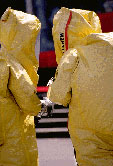
FRIDAY, Oct. 22 (HealthDay News) — Children should receive higher priority in disaster preparedness and response plans, according to the majority of people who took part in a recent survey conducted by the American Academy of Pediatrics and the Children’s Health Fund.
The poll of 1,030 U.S. residents found that:
- If resources are limited, 76 percent agreed children should be given a higher priority for life-saving treatments.
- If difficult decisions are required, 75 percent believe life-saving treatment should be provided to children rather than adults with the same medical condition.
- In the event of a terrorist attack, 92 percent said the United States should have the same medical treatments readily available for children as are now available for adults.
Currently, there aren’t enough stockpiled medications that can be used to treat children in the event of a biomedical threat. Most of the drugs available to treat adults aren’t available in doses or preparations approved for use in children, the AAP said.
“The AAP’s views about prioritizing children’s needs during disasters are shared by the American people,” academy president Dr. O. Marion Burton said in an AAP news release.
“Children represent about 25 percent of the U.S. population. The poll shows that the general public believes we must be better prepared to meet the physical and mental health needs of children in the aftermath of a disaster. Focused attention and federal resources including continuation of the work of the National Commission on Children and Disasters are key to improving this situation,” Burton said.
“Not only is prioritizing the needs of children the right thing to do, it is an essential part of disaster planning in general,” Dr. Irwin Redlener, president of the Children’s Health Fund, said in the news release. “Failing to understand and respond to the needs of children in emergencies can undermine the entire response plan.”
Other children’s advocates agree. On Oct. 6, President Barack Obama and Congress received a National Commission on Children and Disasters report that found persistent gaps in disaster preparedness for children. The report included more than 100 recommendations for improvements.
More information
The U.S. National Commission on Children and Disasters offers resources on children and disasters.

